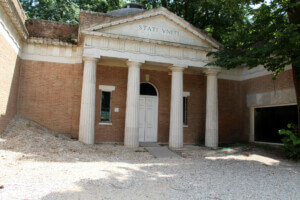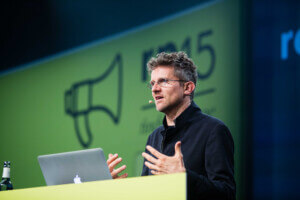[Editor’s Note: The Venice Architecture Biennale is still on through November 23 and it’s still proving to be controversial. Professor Peter Lang shares his thoughts on Rem Koolhaas’ event here.]
A Tale about the Magician Koolhaas who plays Prospero, lives on an island in the Venetian Laguna, and brings a Tempest to the Venice Biennale.
Miranda:
O wonder!
How many goodly creatures are there here!
How beauteous mankind is! O brave new world,
That has such people in’t.
—William Shakespeare, The Tempest, Act V, Scene I, ll. 203–206[5]
(Aldous Huxley quoted this line from the Tempest for the title of his dystopian novel Brave New World published in 1931)
In choosing to take a different perspective on the 14th edition of the Architecture Biennale in Venice directed by Rem Koolhaas, I decided to skip the standard blow-by-blow critique, and instead confront what I believe is the greatest enigma behind this controversial event. Up till now, the majority of critics taking a look at this year’s exhibition find fault with Koolhaas’ method, not so much with his madness. But the key to the exhibition is not in its studied aloofness, but in its insubordination—Koolhaas is determined to shake up the Biennale institution by any means possible.
In all likelihood it didn’t start out this way. Koolhaas went about his business to remake the Biennale as did any major curator in the past, but Koolhaas is ambitious, and he set the stakes very high. To remake the Biennale, Koolhaas would need to dismantle the entire institution in order to rid it of its nearly century old infrastructure, complete with archaic “nationalist” pavilions, an array of inflexible labyrinthine spaces and gigantean maritime buildings, and a legacy of incredibly dated architectural categories. Koolhaas must at some point hit a frustrating impasse, compelling him to look for alternative best practices. It might have been around then that he hit upon the Tempest.
The Tempest has an incredible allure for the kind of intellectual figure who won’t be compromised. The Shakespearean play itself lives on and on: it morphs continuously through time into an incredibly wondrous amalgam of human drama and personal transcendence. The Tempest is a malleable condition, and can double as a playbook for utopian practices, a manual for post-colonial discourse, or a stage for feverish fantasies.
Prospero, the ex-Duke of Milan was a man of great vision and curiosity. While his methods may not be commonly practiced today, he would be of great inspiration to someone like Koolhaas who also faced insurmountable odds. Prospero ruled by sorcery, commanded over an army of slaves, spirits, half humans and fairies. His supernatural powers were based on his immense intellect, drawn from his great library in Milan of which a portion accompanied him in his escape from the city. His strongest affections are reserved for his daughter, Miranda. But the most important cue Koolhaas probably takes from Prospero is dramaturgical, that all spectacle is one big illusion, and that the scenes and characters are but figments of one’s imagination. Prospero evokes the “stuff dreams are made on.” He reveals the insubstantial world of the theatrical craft, masking fiction from truth.
Continue reading the rest of Peter Lang’s essay here.










